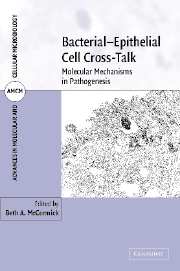Book contents
- Frontmatter
- Contents
- List of contributors
- Part I Introduction to the host and bacterial pathogens
- Part II Bacterial cell biology and pathogenesis
- 3 Bacterial secretion systems
- 4 Microbial molecular patterns and host defense
- 5 Roles of flagella in pathogenic bacteria and bacterial–host interactions
- 6 The role of bacterial adhesion to epithelial cells in pathogenesis
- 7 Bacterial toxins that modify the epithelial cell barrier
- Part III Host cell signaling by bacteria
- Part IV Exploitation of host niches by pathogenic bacteria: mechanisms and consequences
- Index
- Plate section
- References
3 - Bacterial secretion systems
from Part II - Bacterial cell biology and pathogenesis
Published online by Cambridge University Press: 12 August 2009
- Frontmatter
- Contents
- List of contributors
- Part I Introduction to the host and bacterial pathogens
- Part II Bacterial cell biology and pathogenesis
- 3 Bacterial secretion systems
- 4 Microbial molecular patterns and host defense
- 5 Roles of flagella in pathogenic bacteria and bacterial–host interactions
- 6 The role of bacterial adhesion to epithelial cells in pathogenesis
- 7 Bacterial toxins that modify the epithelial cell barrier
- Part III Host cell signaling by bacteria
- Part IV Exploitation of host niches by pathogenic bacteria: mechanisms and consequences
- Index
- Plate section
- References
Summary
To survive in any given niche, bacteria must be capable of sensing, interacting with, and responding to their environment. The method and extent to which bacteria interact with their environment are governed to a large degree by the proteinaceous molecules located on the bacterial cell surface or released into the extracellular milieu. Due to differences in cell-envelope architecture, this process of protein secretion is markedly different between Gram-positive and Gram-negative organisms.
GRAM-POSITIVE VERSUS GRAM-NEGATIVE BACTERIA
Gram-positive bacteria possess a single biological membrane termed the cytoplasmic membrane, which is surrounded by a thick cell wall. The majority of proteins targeted for secretion possess an N-terminal amino-acid signal peptide and utilize the Sec-dependent pathway (Holland, 2004). The Sec machinery is composed of several membrane-associated proteins, including an ATPase (SecA), the Sec translocon (SecYEG), which appears to be the basic unit of cellular life forms, several integral membrane proteins (e.g. SecD, SecF), and a signal peptidase that removes the signal peptide during translocation of the proteins across the cytoplasmic membrane (Dalbey and Chen, 2004). In addition to the Sec pathway, several alternative protein-secretion systems have been recognized in Gram-positive organisms, including the Tat (twin arginine translocation) and ESAT-6/WXG-100 pathways (Pallen, 2002; Robinson and Bolhuis, 2004). However, the role of these systems in protein secretion in Gram-positive bacteria is minor in comparison with the Sec-dependent pathway. Once translocated across the cytoplasmic membrane, the mature protein either can be released into the extracellular milieu or may remain in contact with the cell wall.
- Type
- Chapter
- Information
- Bacterial-Epithelial Cell Cross-TalkMolecular Mechanisms in Pathogenesis, pp. 59 - 98Publisher: Cambridge University PressPrint publication year: 2006



